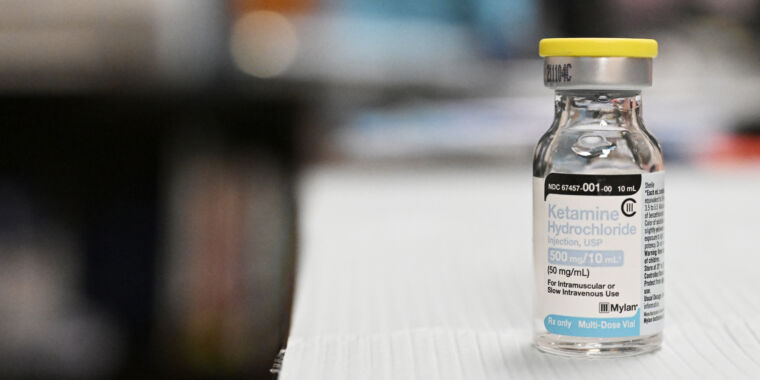enriched and shrinking —
A slow-release oral dose showed good safety, but efficacy is shaky.
Beth Mole
– Jun 25, 2024 8:18 pm UTC
After an MDMA therapy for post-traumatic stress disorder dramatically failed to impress Food and Drug Administration advisers earlier this month, researchers are moving forward with another psychedelic—a slow-release oral dose of the hallucinogenic drug ketamine—as a therapy for treatment-resistant depression.
In a mid-stage, randomized, placebo-controlled clinical trial, researchers tested slow-release ketamine pills, taken twice weekly. The trial, sponsored by New Zealand-based Douglas Pharmaceuticals, found ketamine to be safe compared with placebo. At the trial’s highest dose, the treatment showed some efficacy against depression in patients who had previously tried an average of nearly five antidepressants without success, according to the results published Monday in Nature Medicine.
But the Phase II trial, which started with 231 participants, indicated that the pool of patients who may benefit from the treatment could be quite limited. The researchers behind the trial chose an unusual “enrichment” design to test the depression treatment. This was intended to thwart the high failure rates generally seen in trials for depression treatments, even in patients without treatment-resistant cases. But even after selecting patients who initially responded to ketamine, 59.5 percent of the enriched participants still dropped out of the trial before its completion, largely due to a lack of efficacy.
Enriched design
In the trial’s initial enrichment phase, all 231 participants were given a 120-milligram ketamine pill every day for five days. All the participants knew they were getting ketamine, which could introduce bias if participants expected the drug to work. A few days after their five-day treatment, on day eight, researchers assessed their depression symptoms using a common standardized scale called the Montgomery–Asberg Depression Rating Scale (MADRS). This is a 10-item questionnaire, in which each item is scored 0 to 6 points for a maximum score of 60. The higher the score, the more severe the depression. All 231 participants started the trial with scores of 20 or higher, indicating at least moderate depression. The average score was around 30. The researchers considered a patient to have achieved remission of their depressive symptoms if their score fell to 10 or lower during the trial.
At day eight of the enrichment phase, 132 of the 231 participants (57 percent) achieved remission, and an additional 36 participants achieved at least a 50 percent reduction in their MADRS score. As such, 168 (72 percent) of the initial trial participants moved to the next phase of the trial. Those who did not respond to the drug did not continue on.
The next phase was the randomized, double-blind, placebo-controlled part of the trial, which also tested different dosage levels of ketamine. The 168 ketamine-responsive patients were randomly assigned to one of five groups: a placebo group or a ketamine group, with doses of 30 mg, 60 mg, 120 mg, or 180 mg. The groups’ sizes ranged from 31 to 37 participants. Each group was given their dose twice weekly for 12 weeks.
At the end, day 92 of the trial, the researchers could see a dosage response—that is, there appeared to be step-wise improvements in depressive symptoms between the groups as the dosage increased to the highest level, 180 mg. However, only that 180-mg dosage had statistically significant improvements. At day 92, the remaining participants in the 180-mg group had MADRS scores that were, on average, 6.1 points lower than scores of participants remaining in the placebo group. In other words, participants in the 180-mg group had ending scores that averaged a 14-point drop from their starting MADRS score, while the placebo group showed, on average, an 8-point drop.
The researchers reported that these results showed “statistically significant and clinically meaningful improvement in depressive symptoms.”
Dropouts
However, it’s important to note that by day 92 of the trial, only 68 of the 168 ketamine-responsive participants remained in the trial. The other 100 participants (59.5 percent of the 168) had dropped out by then. Of the 100 who dropped out, 94 did so due to a lack of efficacy (defined as scoring 22 or higher on MADRS amid the trial). For the other six, four dropped out for unspecified reasons, one dropped out over an adverse event, and a 65-year-old man in the 180-mg dose died by suicide on day 42 of the trial. The researchers running the trial determined it was due to depression.
At day 92, only 11 of 37 participants remained in the placebo group, and 18 of 32 remained in the 180-mg dose group. Thus, the ending 6.1-point statistically significant difference calculated between the placebo group and the 180-mg dose group was based on scores from just 29 of the 168 participants.
The authors acknowledge that their trial design “is likely to overestimate population levels of treatment response” and that “future unenriched clinical trials are needed to address this issue.”
In the meantime, the researchers reported that the oral doses of ketamine appeared to be safe. In the trial, there were no cardiovascular side effects noted, particularly no increased blood pressure readings as has been seen with ketamine before. There were also low rates of dissociation and also very low rates of sedation, the researchers wrote. Otherwise, common side-effects included mild to moderate headache, dizziness, anxiety, depressed mood, and dissociation.
The study did not collect specific data on potential abuse or diversion. Most of the dosing in the second phase of the trial occurred at home, which may raise concerns among clinicians. The researchers only reported anecdotally that they were not aware of any participants craving the pills. They also noted that the ketamine tablets are difficult to break open. One participant was removed from the trial due to “lack of compliance.”
Page: 1 2 Next →
>>> Read full article>>>
Copyright for syndicated content belongs to the linked Source : Ars Technica – https://arstechnica.com/?p=2033492
